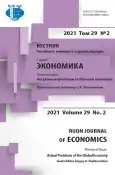Современное курсообразование в ресурсно-ориентированной экономике: институциональный аспект
- Авторы: Буневич К.Г.1, Горбачева Т.А.1
-
Учреждения:
- Московский университет имени С.Ю. Витте
- Выпуск: Том 29, № 2 (2021): АКТУАЛЬНЫЕ ПРОБЛЕМЫ ГЛОБАЛЬНОЙ ЭКОНОМИКИ
- Страницы: 266-277
- Раздел: МИРОВОЙ РЫНОК КАПИТАЛА
- URL: https://journal-vniispk.ru/2313-2329/article/view/324219
- DOI: https://doi.org/10.22363/2313-2329-2021-29-2-266-277
- ID: 324219
Цитировать
Полный текст
Аннотация
В современных условиях возрастает потребность в проведении углубленных теоретических и прикладных исследований сущности, структуры и особенностей формирования валютного курса, развитии механизма валютного регулирования в РФ, определении степени государственного регулирования валютных отношений, в том числе из-за введения валютных ограничений, выяснении основных критериев эффективности их применения, а также разработке направлений совершенствования механизма валютного регулирования в условиях посткризисного экономического развития. Основная цель исследования - рассмотреть особенности формирования валютного курса в условиях ресурсоориентированной экономики, к числу которых относится российская экономика с институциональной точки зрения. Использованы общенаучные методы, в частности анализ, синтез, сравнение, а также системный подход к изучению информации. Обозначено значение валютного курса для экономики. Охарактеризованы основные показатели валютных курсов и основные группы факторов, влияющие на курс национальной валюты.
Об авторах
Константин Георгиевич Буневич
Московский университет имени С.Ю. Витте
Автор, ответственный за переписку.
Email: kbunevich@muiv.ru
кандидат экономических наук, доцент, заведующий, кафедра финансов и кредита
Российская Федерация, 115432, Москва, 2-й Кожуховский пр-д, д. 12, стр. 1Татьяна Александовна Горбачева
Московский университет имени С.Ю. Витте
Email: t-gorbacheva@bk.ru
кандидат экономических наук, доцент, кафедра финансов и кредита
Российская Федерация, 115432, Москва, 2-й Кожуховский пр-д, д. 12, стр. 1Список литературы
- Auty, R.M. (2001). Resource abundance and economic development. Oxford: Oxford University Press.
- Bova, E., Medas, P., & Poghosyan, T. (2016). Macroeconomic stability in resource-rich countries: The role of fiscal policy: IMF Working Paper WP/16/36. International Monetary Fund.
- Bozhechkova, A.V., & Trunin, P.V. (2016). Analysis of the dynamics of the real exchange rate of the ruble (p. 97). Moscow, “Delo” RANEPA Publ. (In Russ.)
- Bozhechkova, A.V., Sinelnikov-Murylev, S.G., & Trunin, P.V. (2020). Factors of the ruble exchange rate dynamics in the 2000s and 2010s. Economic Issues, (8), 5–22.
- Chernysh, N.A., & Buryanova, N.V. (2016). Exchange rate: Factors influencing its formation. Science and World, 2(12), 47–49. (In Russ.)
- Embulaev, V.N. (2017). The development of Russia’s economy and the “Dutch Disease”. The Herald of Vladivostok State University of Economics and Service, 9(2), 53–63. (In Russ.)
- Faltermeier, J., Lama, R., & Medina, J.P. (2017). Foreign exchange intervention and the Dutch disease: IMF Working Paper WP/17/70. International Monetary Fund.
- Gavrilova, E.N., & Bunevich, K.G. (2020). Factors of formation of the exchange rate of the Russian ruble. Current Issues of the Modern Economy, (9), 230–233. (In Russ.)
- Kholopov, A.V. (2018). Exchange rate policy in the system of macroeconomic regulation measures. Economic Horizons, (5), 107–113. (In Russ.)
- Kondratev, V. (2016). Resource-based economic growth. World Economy and International Relations, 60(1), 41–52. (In Russ.) https://doi.org/10.20542/0131-2227-2016-60-1-41-52
- Korechkov, Yu.V. (2020) Currency wars: Political and economic nature, causes and consequences. Theoretical Economy, (1), 29–34. (In Russ.)
- Kosarev, A. (2014). Purchasing power parity – a unique tool for international comparisons. Voprosy Statistiki, (5), 63–72. (In Russ.) https://doi.org/10.34023/2313-6383-2014-0-563-72
- Moiseev, S.R. (2016). Foreign exchange intervention. Motives of central banks and their tools. Russian Journal of Money and Finance, (3), 12–19. (In Russ.)
- Niyazbekova, Sh.U., & Bunevich, K.G. (2018). Mechanism of exchange rate formation. Vestnik RIAT, (4), 45–50. (In Russ.)
- Oleynikova, I.N. (2018). Key aspects of using sovereign funds in solving the structural problems of the national economy. Vestnik of Astrakhan State Technical University. Series: Economics, (2), 61–72. https://doi.org/10.24143/2073-5537-2018-2-61-72
- Prilepskiy, I.V. (2020). Impact of external currency exposures on macroeconomic policies. Voprosy Ekonomiki, (8), 23–40. https://doi.org/10.32609/0042-8736-2020-8-23-40
- Rodin, D.Ya., & Bulokhova, E.V. (2018). Exchange rate and factors influencing its forma- tion. Symbol of Science, (7), 70–74. (In Russ.)
- Sachs, J.D., & Warner, A.M. (1995). Natural resource abundance and economic growth. NBER Working Paper Series. Working Paper No 5398. Cambridge: National Bureau of Economic Research.
- Skurikhin, A.S. (2019). Aspects of interaction between Russia's financial and monetary policy. Current Problems and Prospects of Economic Development: Russian and Foreign Experience, (3), 92–102. (In Russ.)
- Solyannikova, S., & Bondarenko, N. (2019). Trends in the development of sovereign funds as a tool of budgetary policy. Economics, Taxes & Law, 12(1), 57–67.
- Tetyushin, A.V. (2020). Currency interventions of the Central Bank of the Russian Federation in the context of the coronavirus pandemic and falling oil prices. Economics and Business: Theory and Practice, (4–3), 93–97. (In Russ.)
- Zharikov, M. (2019). Currency wars within the existing international monetary system. Obshchestvo i Ekonomika, (8), 89–95. (In Russ). https://doi.org/10.31857/S020736760006129-0
- Zikunova, I.V. (2017). Fundamental factors of dollar-ruble exchange: Expectations for 2017. Scholarly Notes of Komsomolsk-na-Amure State Technical University, 2(1), 79–84. (In Russ.)
- Zubarev, A.V., & Trunin, P.V. (2014). Impact of the real exchange rate on economic activity in Russia. Studies on Russian Economic Development, (2), 92–102. (In Russ.)
Дополнительные файлы









